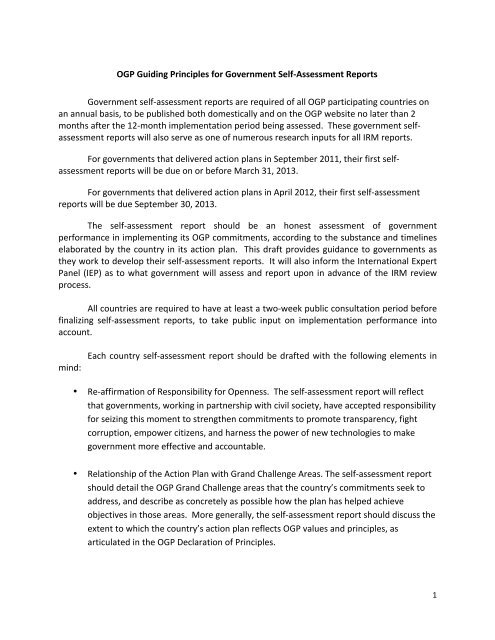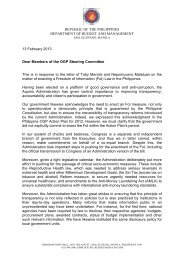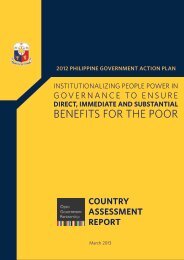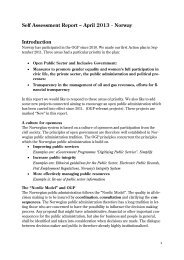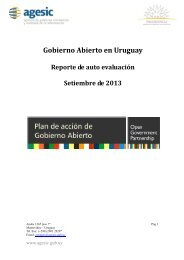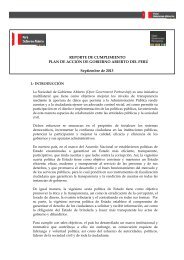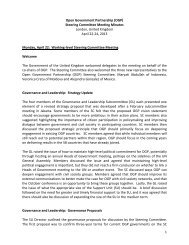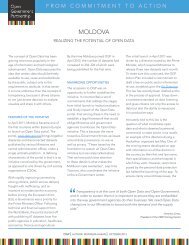Final Government Self Assessment Guidelines_0_0.pdf - Open ...
Final Government Self Assessment Guidelines_0_0.pdf - Open ...
Final Government Self Assessment Guidelines_0_0.pdf - Open ...
Create successful ePaper yourself
Turn your PDF publications into a flip-book with our unique Google optimized e-Paper software.
OGP Guiding Principles for <strong>Government</strong> <strong>Self</strong>-‐<strong>Assessment</strong> Reports <strong>Government</strong> self-‐assessment reports are required of all OGP participating countries on an annual basis, to be published both domestically and on the OGP website no later than 2 months after the 12-‐month implementation period being assessed. These government self-assessment reports will also serve as one of numerous research inputs for all IRM reports. For governments that delivered action plans in September 2011, their first self-assessment reports will be due on or before March 31, 2013. For governments that delivered action plans in April 2012, their first self-‐assessment reports will be due September 30, 2013. The self-‐assessment report should be an honest assessment of government performance in implementing its OGP commitments, according to the substance and timelines elaborated by the country in its action plan. This draft provides guidance to governments as they work to develop their self-‐assessment reports. It will also inform the International Expert Panel (IEP) as to what government will assess and report upon in advance of the IRM review process. All countries are required to have at least a two-‐week public consultation period before finalizing self-‐assessment reports, to take public input on implementation performance into account. mind: Each country self-‐assessment report should be drafted with the following elements in • Re-‐affirmation of Responsibility for <strong>Open</strong>ness. The self-‐assessment report will reflect that governments, working in partnership with civil society, have accepted responsibility for seizing this moment to strengthen commitments to promote transparency, fight corruption, empower citizens, and harness the power of new technologies to make government more effective and accountable. • Relationship of the Action Plan with Grand Challenge Areas. The self-‐assessment report should detail the OGP Grand Challenge areas that the country’s commitments seek to address, and describe as concretely as possible how the plan has helped achieve objectives in those areas. More generally, the self-‐assessment report should discuss the extent to which the country’s action plan reflects OGP values and principles, as articulated in the OGP Declaration of Principles. 1
• Summary of Action Plan Development Process. The self-‐assessment report should also summarize the action plan development process, including mechanisms and processes through which consultation with civil society has occurred. To this end, the report should discuss the degree to which the government followed OGP process requirements and guidance in the development and implementation of plans, in keeping with the OGP roadmap requirements. • Summary of Progress on Action Plan Implementation. The self-‐assessment report will address whether OGP commitments were implemented according to the timeline and milestones established by the country in its action plan – and whether each commitment has been fulfilled, partially fulfilled, withdrawn, in progress, or not met. • Summary of Progress on Eligibility Criteria. Countries that have voluntarily taken steps to improve their performance on OGP eligibility criteria as part of their action plans should identify those actions and outcomes. • Detail Challenges and Lessons Learned. The self-‐assessment report will note the challenges governments faced throughout the plan development and implementation processes, whether anticipated or unanticipated. It will provide thoughts on some of the lessons the government learned throughout the process. • Next Steps. The self-‐assessment report will summarize anticipated next steps for unfulfilled OGP commitments. It will reiterate the country’s commitment moving forward to continue to implement its Action Plan – and how it will build on the challenges faced and lessons learned. • Uniqueness of Country Approach. <strong>Government</strong>s are encouraged to follow the template provided, however, the self-‐assessment report will reflect that countries are at different stages in their efforts to promote openness in government. Each country should pursue an approach consistent with national priorities and circumstances and the aspirations of its citizens. • Availability and Accessibility to Public. The government self-‐assessment reports will be made publically available in the local language(s) and in English, and deposited on the OGP portal. 2
• Advance <strong>Open</strong> <strong>Government</strong> Goals. The self-‐assessment report will contribute to advancing open government internationally by sharing best practices, achievements, and challenges in the implementation of respective action plans. SPECIFIC GUIDANCE ON CONTENT OF GOVERNMENT SELF-‐ASSESSMENT REPORTS I. Introduction and Background • Summary of action plan and priorities which explain • How the country’s OGP commitments reflect the country’s commitment to the four core open government principles OGP adopted (transparency, citizen participation, accountability, and technology and innovation). • How did the country’s OGP commitments attempt to address at least one of the 5 OGP grand challenges (improving public services, increasing public integrity, more effectively managing public resources, creating safer communities, and increasing corporate accountability)? II. Process Summary • Provide a narrative of the government’s approach to plan development and implementation process as related to core OGP principles which includes: o How the government developed the plan o What process challenges, if any, the government faced in developing the action plan in terms of §§§Fostering citizen participation Organizing inter-‐agency and/or Central/Local consultation mechanisms Developing the plan in a timely manner o What innovations or new approaches were a part of the plan development process (i.e. inclusion of civil society on drafting committee, sub-‐national engagement, online reporting, inter-‐agency coordination, etc…)? o How the government engaged the OGP networking mechanism, or other tools/bodies/international institutions in developing the action plan. 3
• Provide details of the government’s approach to multi-‐stakeholder engagement in plan development and implementation. This should include a narrative of civil society consultation with reference to guidelines in Articles of Governance which includes: o Whether the government made details of the public consultation process and timeline available, online and in local language(s) at a minimum, prior to the consultation. o Whether the government consulted the public through a variety of mechanisms – including online and through in-‐person meetings – to ensure the accessibility of opportunities for citizens to engage. o Whether and how the government widely consulted with a broad range of stakeholders with the national community, including civil society and the private sector; sought a diverse range of views; and made a summary of the public consultation and individual written comment submissions publicly available and accessible. o Whether and how the government engaged in OGP awareness-‐raising activities to enhance public participation in the consultation. o Whether the government identified (and utilized) a particular forum to enable regular multi-‐stakeholder consultation on OGP implementation (did consultations take place through an existing entity or a new one)? III. Implementation of Country Action Plan • Summary of total number of commitments fully implemented, partially implemented, in process or not implemented at all during the assessment period. • For each commitment, the government should be encouraged to include the following information (both textually and visually): o The nature of the commitment made, timeline, and related activities. o Narrative of what government accomplished with respect to each commitment, including assessment of whether the commitment has been fulfilled, partially fulfilled, in progress, withdrawn or not met. o Describe what remains to be achieved with respect to each commitment. o Explain mitigating circumstances/explanations and observations around challenges related to implementation of each commitment. 4
o Report on the positive impact of the activities and related outcomes with respect to each commitment; this could include a broader assessment that may detail actions taken outside the action plan itself, such as political/electoral developments, cultural changes, and plans for the future unrelated to last year’s commitment. o Where relevant, report on the reasons why a commitment has not be fulfilled, if it will continue to be a goal and what the new timeline for fulfilling it is. o Lay out plans for completion/furtherance of commitments going forward. o Point out risks surrounding ongoing projects and the continuity of accomplished goals. o Where relevant, include a summary of the government’s engagement with the networking mechanism and/or other international institutions and external stakeholders such as the private sector. IV. Conclusion, Other Initiatives and Next Steps • What were overall lessons learned and challenges encountered with respect to plan development and implementation? • What are next steps with regard to unfulfilled commitments, and next steps with regard to OGP generally? • In what ways could process and implementation be improved with respect to OGP roadmap and principles espoused in Declaration? • What other innovative measures were adopted to help to meet the challenges of OGP that were not originally reflected in the action plan? 5


